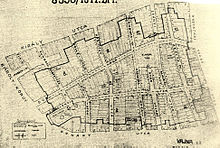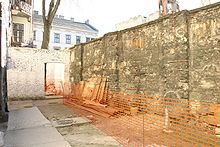Budapest ghetto
The Budapest Ghetto was created by decree of November 29, 1944 in the VIIth district of Budapest . It existed from the end of November 1944 to January 27, 1945. Thousands of people died in the ghetto, but around 70,000 people survived there. 25,000 Jews had hidden outside the ghetto and a further 25,000 had been able to evade persecution with protective passports .
Before the founding of the Jewish ghetto

The Jews outside Budapest were rounded up and deported from mid-April to July 1944, until on July 7th Miklós Horthy ordered the deportations to be stopped. The Jews of Budapest were not initially concentrated in a ghetto. Instead, the then mayor ordered in June 1944 that all Jewish residents of Budapest had to move to so-called star houses, which were marked with a Star of David, between July 17 and 24. These 2,639 buildings with a total of 70,197 rooms were scattered throughout the city.
Establishment of the Jewish ghetto
On November 18, 1944, the Jewish council, which governed the Jewish community , was officially informed that the residents of the star houses were to move into a neighboring ghetto in the seventh district. The layout of the area is also given in the regulation. The decree stipulated that Jews who had to wear a yellow star in Budapest should move to an area of about 0.3 square kilometers. The deadline for the move was December 7, 1944. The non-Jewish people living there had to leave their homes. They got another apartment. There were a total of 162 star houses in the designated area. The Jews who were forced to be interned reached the centrally located Klauzál Square , where their valuables were confiscated. The four central gates were guarded by soldiers. Originally, around 63,000 Jewish residents, mostly elderly and under 16s, were expected to accommodate an average of 14 people per room. The corpses were piled up in various locations. Such isolated places were the Klauzál Square, called the mikveh , and the courtyard of the local synagogue . Only the cold prevented an outbreak of the disease. The supply of elderly people and patients was severely limited by the lack of medication.
Liberation of the Jewish ghetto
In January 1945 rumors circulated that the ghetto would be bombed by the Germans before the Soviets got there. On January 17th and 18th, 1945, the Soviet troops reached the center of Pest . While the fighting in Buda continued, the plague ghetto was liberated and its armed guard disappeared. The wooden fence built around the ghetto was used almost immediately for firewood. 68,000 people survived the internment. After the liberation of the ghetto, around 3,000 dead were found. Most of them were buried in mass graves .
Web links
Individual evidence
- ^ Israel Gutman et al. (Ed.): Encyclopedia of the Holocaust . Munich and Zurich 1995, ISBN 3-492-22700-7 , Vol. 1, p. 254.
- ^ Israel Gutman et al. (Ed.): Encyclopedia of the Holocaust . Munich and Zurich 1995, ISBN 3-492-22700-7 , Vol. 1, p. 252.
Coordinates: 47 ° 30 ' N , 19 ° 4' E
